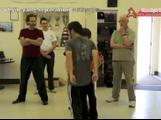- Missing one step. Do not miss any step: 1) in with elbow, 2) turn with the waist. Do not combine. Follow the steps. Follow the procedure. Follow the instruction
Today several students received partial Yilu corrections. Form corrections are always foundational.
Jacek Wolochowski
- In with elbow. Not enough elbow
- Elbow in. The elbow is leading. Get rid of sideways moves. Only one line
- When you don’t move the Hand, it forces you to move the elbow, shoulder and waist
Jody Hall
- Elbow and kua
- Elbow/Hand relationship: we need a twist. Not double heavy. It is possible because in your forearm you have 2 bones
- Exercise: somebody is holding your hand to ensure it does not move. Twist the elbow in
- To pull in is to push out. Withdraw is to issue. This is Peng (example of hitting a drum: when you hit, the outside is stretching outward to equalise the inward stretch of the inside)
Yuxin Liu
- Cloud Hands: number 2 (turn with waist) not strong/clear enough
- Turn with waist does not link to the knees. Eyes and knee must remain
- Your move will be deeper if you add the turn
Kevin Chen
- Example: opening a bottle by holding the cap and twisting the bottom. Then reversed action.
- Upper body/Lower body: lock dantian and knees, only rotate the top
- Example with a piece of paper: at the beginning, as an exercise, we hold the middle and move the two ends. Later on we hold one end and move the other one. Only the rear kua is stretching, the front kua is not moving.
Lutz Liese
- Moves too small
- You have to do the Form as if it is inside a square. You have to physically touch it. We want to have real size
- On the way out, you have to become very big. On the way in, you have to become very small. Inside/Outside: reach the extreme.
- At the beginning is physical. At the end is intention
Pawel Müller
- You have to create a feeling that you’re breaking out of something, yanking something, breaking something
Sevastianos Maillis
- Put some real effort. Real power
Felicia Fong
- Torso straight
Barb Steger
- Moves too small
- Every move you have to come back in
- In with elbow: become very small. Out with hand: become very big
Travis Knaub
- Do the Form with low and wide stance
- Embrace the Head to Push the Mountain: you have to be so big you’re going to fall down
- Directions: 45 degrees and straight
Paul Pryce
- Shoulder and kua are not wide open enough
- Exercise: hold onto two bars and move the inside a lot, rotate shoulders and kua
Simon Yau
- First move: rear shoulder too high
- Don’t rush
- Pay attention to the elbow
- You have to learn with method. Which move is causing what
- When you look at people, you should be able to see what they are trying to do
Questions
Question and Answer related to Baihui and vertical line. Everything you do has two actions. The first one is irrelevant, never right or wrong. The second one is important. Example with rubber cord: Master Chen holding one end. Wherever and however you place it, is not important. Once you place it, you are setting a point of reference. Master Chen holding the second end and stretching it away from the other end. This is the second action.
Further example with circle: in and out actions cannot be on the same track. Where we do the first half is not relevant. The second half must be the opposite. Coming in from the bottom, must go out from the top. Coming in from the top, must go out from the bottom.
Master Chen often teaches us not to ask questions. And then he tells us to ask question. We need to understand the nature of questions.
There are Question, Assertions and Discussion. We often confuse them.
A real question is to point to a place and let Master Chen explain. Don’t say “Should it be like this or like that?” By doing this we have already made an assertion. When we do this, we are limiting the answer to a box containing things we already know. The answer is often outside of the box.
Hong’s Method: never listen to students. Only make the right move for them to see
Power/Distance
Master Chen used the Cloud Hands to explain the kua action. With a telescopic stick: holding the two ends, one end (front kua) stretches away from the other end. The stick has become longer. Then lock the front end (front kua), only stretch the rear end (rear kua) toward the front end (front kua). The stick has become shorter. By repeating the procedure, the stick was advancing in space.
Power=you generate huge distance
Master Chen took another move to demonstrate the same thing. Buddha’s Warrior
One end of the telescopic stick was touching his chest. If you don’t lock this dot, nothing happens to the stick. If you do lock the dot, the stick is being pushed. It became shorter. If you do it correctly, you are covering distance.


